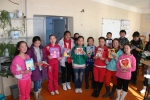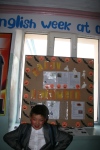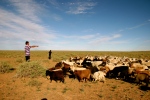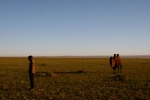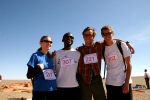Keep them in your thoughts…
We all got some very sad news about fellow Volunteers in Mozambique today.
You can find the press release here.
Meanwhile, on the other side of the world…
Thanks to the incredible generosity of the first graders at Montclair Elementary School in Omaha, Nebraska, and from my very own Aunt Liz and Aunt Ann, the library here in Mongolia is growing by leaps and bounds!
This is absolutely incredible. The first boxes began to arrive about a week ago, and last Saturday we had a special class so students could come and see all of the wonderful new books that you’ve sent them for their new English library. This week I’ve been busy cataloging all the new books and putting them into an Excel spreadsheet so students can begin to check them out. I’ve got some pictures to share with you, so you can all see just how excited everybody was to get such a wonderful gift this December.
As the books continue to arrive, I’ll keep taking pictures and posting them as I can. Also, the students around here are going to write the 1st graders of Montclair Elementary a big pile of thank you cards that hopefully I can send off to Nebraska in the near future. From me, my fellow teachers, and my students, THANK YOU!
Time and Space, Space and Time.
Midwinter spring is its own season
Sempiternal though sodden towards sundown,
Suspended in time, between pole and tropic.
When the short day is brightest, with frost and fire,
The brief sun flames the ice, on pond and ditches,
In windless cold that is the heart’s heat,
Reflecting in a watery mirror
A glare that is blindness in the early afternoon.
In recent weeks, I’ve been nagged by a sense of space and time. I say nagged, because it keeps surprising me while I’m reading or listening to something. It comes from my familiar headwater of ideas and information: good ol’ fashioned books and podcasts. Call it Reading-Stephen-Hawking-in-the-Gobi Syndrome, but really, it’s been cropping up in too many things to count. I’ll just mention one because it’s concise. A Radiolab episode describes a Peace Corps Volunteer spending two years in the jungle in Africa. He’d lived in a small community, surrounded on all sides by dense forest—the people of his community only cleared enough of the forest to make room for small huts and meeting spaces. At the end of his service, he left the jungle and spent two weeks on the plains of Kenya with a friend, another Volunteer. The first, the one who had lived in the jungle, described his profound sense of anxiety and unease at now being exposed on the open plain. Without the comforting concealment of the forest, he always felt as if something was creeping up behind him.
The story worked itself in. I’d always been one to consider the vastness of the Mongolian countryside, and the Gobi in particular, as awesome, in the truest and most literal sense of the word. But I often have to stare at the ground when I walk to school, because the view almost triggers something like horizontal vertigo—instead of feeling like I might fall, I feel like I might walk forever and never find the end—like the axes on some giant, three dimensional graph of time and space.
Here I’ve been occupying this 12-foot in diameter circular tent for nigh on 15 months, every day stepping a little closer to closing what’s sure to be a major chapter of my life. The contrast between this little felt cave and that enormous horizon is part of the unease. I’ve also watched my town experience the explosive growth and development that mining money and job opportunities can offer when one of the largest coal deposits in the world is only a stone’s throw away. But mining is at once a rose and the thorn. I’ve been witness to millions of tons of rock pulled from the earth and moved around by machines that dwarf even the largest dump trucks you’ve seen with your average American road crew.
That is to the south of town. All I have to do is turn north to catch a glimpse of a desert that probably hasn’t changed a whole lot since the last ice age, and probably won’t change any time in the near future. Here I am, in the presence of both, and the collusion of the space and the time makes me a little uneasy—makes me feel a little exposed. I guess we just don’t notice these things until all of a sudden we do: the old and the young alive together, buildings that are older still, traditions and speech that are older than that, with the earth and rocks clocking in some time before that. It’s something the desert is uniquely capable of making apparent. I chalk it up to the size of the canvas and the scarcity of brushstrokes—like the way that painting by Georges Seurat looks strange up close but becomes an orderly picture from far away—you know the one, the painting of a Sunday afternoon in the park, featured momentarily in Ferris Bueller’s Day Off. Maybe those wild assertions of quantum physicists, about all times existing at once, aren’t so far off when we have a moment to break it down and take a long hard look at the picture in front of us.
The linearity of all of it is a little bit of an illusion, and so my fear of that particular line in Mongolia ending, of closing that chapter, is unfounded. As I said, it’s my open plain, and my exposure is limited only to my own introspection, no need to feel like it’s creeping up behind me. I have to believe that the person I’ve become here in Mongolia has a reality that follows me home, and conversely that the learning and changing I’ve done is really just a facet of the person I always thought I was. I can’t bear the thought that between here and there is an event horizon that refuses to let each time and place speak to the other, both the before and the after. Travel long enough in one direction and you’ll end up where you started, someplace where this soup of experiences and opinions somehow makes itself into a recognizable picture, and someplace where progress and being who we always were are one in the same.
We shall not cease from exploration
And the end of all our exploring
Will be to arrive where we started
And know the place for the first time.
Through the unknown, unremembered gate
When the last of the earth left to discover
Is that which was the beginning;
At the source of the longest river
The voice of the hidden waterfall
And the children in the apple-tree
Not known, because not looked for
But heard, half-heard, in the stillness
Between two waves of the sea
Quick now, here, now, always—
A condition of complete simplicity
(Costing not less than everything)
And all shall be well and
All manner of thing shall be well
When the tongues of flame are in-folded
Into the crowned knot of fire
And the fire and the rose are one.
-T. S. Eliot
Pretty much right on the money…
HuffPo has a good article about failure from a recently returned volunteer. Read it HERE.
Mongolian Mysticism
It’s been a slow process making friends in the soum, but I count myself lucky. I’ve got lots of acquaintances and most everybody knows my name, even if I don’t know them. Word about the one foreigner in town gets around quick.
A few relationships have taken on a more interesting shine this second year though. I’ve got a group of guys I truly enjoy. Many interactions with my co-workers and other people around town never leave the realm of what they need from me, or what I might need from them, but this group of three other guys is purely social, and our similar interests and temperaments is finally something that transcends the sizeable valley between our cultures and backgrounds. Who are they? Two traditional Mongolian wrestlers and a shaman, which, if you’re going to be the only foreigner in a town and the target of harassment, is probably the best team you can hope for.
On a Sunday morning, my friend Saikhna called me up and asked me if I’d like to come and watch Suren, the shaman, speak to the spirits. I told him, “Absolutely.” Mongolian Shamanism has been a part of my fascination with the country. After the breaking of the Soviet hold on Mongolia, the country has slowly been rediscovering it’s spiritual roots, namely Buddhism, but also the more ancient and native Mongolian shamanism. Mongolia’s brand of Buddhism comes chiefly from Tibet (and of course India before that), but the shamans and their traditions were born right here on the Central Asian steppe.
There have been a handful of times when I’ve felt connected in a transcendental way to the whole of human history that precedes my own life: walking the streets of Pompeii, listening to carols on Christmas Eve in Notre Dame Cathedral, standing beside cairn burials in Scotland and Ireland, being in the presence of Stonehenge…and this. I wandered over to my friend’s ger and found a comfortable spot to sit, out of the way. Other Mongolian guests began to trickle in seeking the counsel of the spirits for whom my friend Suren was about to become the conduit. The ceremony began with Suren’s mother moving around the ger and covering up mirrors and any reflective surfaces, including the flat screen television. I asked about this, and my friend explained that it’s because the spirits floating in the ger during the ceremony might be reflected in the mirror.
Once all reflective surfaces were covered, Suren and his mother opened the shrine at the back of the ger. A small table was covered in small bronze cups, the ankle bones of goats and sheep, figures representing the primary animals of Mongolia (horses, camels), incense burners, and a large bronze mask was hung just above the table, surveying it all. A chunk of mutton was resting in one side of the mouth of the mask, and Suren placed a cigarette on the other side as an offering of tobacco to the spirits. He also lit sticks of incense, and three old-fashioned tallow candles, representing the ancestors that aid him in speaking to the sky. He filled the bronze cups with milk, aruul (dried milk curd), and vodka, then he drenched all the figures of animals and ancestors in both vodka and milk.
When the shrine was prepared, Suren started to put on his shaman garb: a long robe draped in strips of cloth sewn to look like snakes, along with strings of beads across his chest and wrapped around his left wrist. On his right arm, he tied a shamanic totem made of bone and beads, and also the carved wooden mallet that would be the stick for his final accessory—the drum. As he was picking up the drum, Suren turned to me, smiled and said, “Ene minii tengeriin mashine,” meaning, “This is my car to the sky.” The drum was nine-sided, covered in cow-skin, with small bells tied at the apex of each adjoining piece of the wooden nonagon.
Suren’s mother and Saikhna then covered his clothing and the drum in milk and vodka, another purification. Then they offered him a small bowl of milk. Suren drank the whole bowl, and tossed the bowl on the ground. Everyone watched as it rolled and eventually landed face down. Suren’s mother picked it up again and filled it, Suren drank and tossed it in the same way—again it landed open side down. They continued this until eventually it landed facing up. This meant that Suren’s purification was complete and he was allowed to begin the ceremony.
Suren sat cross-legged in front of the shrine and started to beat the drum, with his face right behind it and I could hear him singing softly as he did so. After a while, Saikhna stepped up behind him as he took a pause in his drumming and drew an elaborate headdress down over his head. Black feathers stood up from his forehead, a black cloth with eyes sewn into it obscured his vision, long black threads covered the lower half of his face, and long trails of colorful cloth ran down his neck and over his back. Suren stood and drummed more intensely until he was taken by a spirit, at which point the drumming stopped and he stooped as if he were a very old man. Saikhna and Suren’s mother helped him sit and greeted him as a weary traveler. The spirit announced himself, told the room his age, and gave a ceremonial greeting. Saikhna offered him hot milk-tea, traditional Mongolian vodka, and an old-style pipe packed with aromatic tobacco.
What followed was a series of spiritual visitors, each one greeted anew, talking to the people that had come to the ger to speak with them. People asked about businesses, jobs, cars, newborns, grandparents, husbands, wives, boyfriends, and girlfriends. Each spirit had it’s own personality, some were elderly grandmothers, gentle and welcoming, some were dignified old men, and still others were angry and uncouth old warriors. One grandmother insisted that even I take a small drink of milk and ask for a blessing. When the spirits were finished, Suren finally removed the headdress, once again sat cross-legged before the shrine, and beat the drum to thank the spirits for their visit.
I’d love to tell you I had photos of all of this, but to me it just didn’t feel appropriate. I’d feel strange gawking and photographing such an ancient and sacred rite. And, as an armchair anthropologist, I was far too intrigued by what I was seeing to even spare a moment for fiddling with a camera.
These are my friends in Mongolia, similarity beyond culture and national identity: truly human brotherhood.
For a little more on Mongolian shamanism, look here.
A Happy Halloween!
A primary goal this year has been the development of a skeletal plan for extracurricular, English-language activities for the students that can hopefully survive after I’ve gone home. The reality of teaching ESL is that 40 minutes a day isn’t nearly enough to bring the language to any sort of usable level—I wanted to provide a yearlong framework where students who wanted to, could participate in clubs, generate English creative work, and share in American holidays and traditions. It gives me some power, honestly, as the actual curriculum is rigid and defined on a national level by the Ministry of Education and Culture, but the things we do with the students outside the classroom give my counterparts and I leeway to be more creative with our activities and teaching styles. The library is a big part of this, but last week, so was our Halloween party.
My counterpart and I planned an entire day of special activities for costumed students: games, Halloween vocabulary contests, awards for the best costumes and decorations, and even the Charles Schulz classic, It’s the Great Pumpkin, Charlie Brown. At night, we had a Halloween dance in the gymnasium with a mummy race (students race to wrap a teacher in toilet paper as fast as they can), bobbing for apples, and a whole lot of students just breakin’ it down. I’ve got some pictures of our celebration to share!
Others Have Said It Better
I’ve spoken briefly, more likely at great length, about what podcasts have meant to me here. I spend so much time alone in my ger (more depressing than I intend it to sound), that many of these radio personalities have come to feel like friends. Really, I need time to unwind, and being by myself in my ger is often the best way to do that here. The Peace Corps is, at its heart, a twenty-four hour job. The moment I step outside, I am, for better or worse, a representative for all things American, simply by virtue of the fact that I’m the only one for a hundred miles. Being alone is the only reliable time when I’m allowed to be myself. For company, I’ve chosen books, movies, TV shows, but more than anything else, I’ve chosen podcasts. Friends have recommended many to me over the last 17 months, “Desert Island Discs,” “A History of the World in 100 Objects,” “How Stuff Works,” etc.
For a glimpse into what I think may be the future of spoken word entertainment, (i.e. what I like to call radio these days), I’ve compiled a list of my top ten absolute must hears! They are in order, but feel free to jump around as suits your taste. (NOTE: I’ll try to include links wherever possible, but honestly, most of these can be found on iTunes if not on their website)
10. “How Peace Corps Works,” from How Stuff Works Podcast. This is an easy choice really, it’s a podcast I’ve been listening to for some time now, and they finally threw us a bone! So many of us are fans. Find it in the list here.
9. “The Super,” This American Life. Storytelling and investigative journalism at its best. The link to the show on their website is here.
8. “Act V,” This American Life. Find it here. The story of convicted felons putting on their very own version of Hamlet. Listening to these men explain how they identify with their character should put everyone who proclaims to be a “method actor” to shame.
7. “#47 Sutton Hoo Helmet,” A History of the World in 100 Objects. Find it here. If you know me, you know I’m a little bit in love with Anglo-Saxon England. William the Conqueror and the Battle of Hastings was at once the best thing, and the worst thing, ever to happen to the British Isles.
6. “Falling,” Radiolab. Right here. Every possible permutation of this word is explored. For an English major, who doesn’t love to explore just what we mean when we say we “fall.”
5. “Cities,” Radiolab. Here. Before I left the States, I’d decided to make New York my home. Why does this city work the way it does? Why does any city for that matter?
4. “In the Shadow of the City,” This American Life. Here. The boundary, what’s within and what’s without. This episode is incredible.
3. “Space,” Radiolab. Here. We, human beings, in the grand scheme of the universe, are quite insignificant.
2. “Valentine’s Day 2008,” This American Life. Here. Stories about love long after the “lightning” has struck. What does it mean to say “I do,” and everything that comes along with it.
1. “20 Acts in 60 Minutes,” This American Life. Here. Telling stories aloud is, at its heart, about making somebody forget their own troubles–if even for a moment. This is microfiction (or nonfiction) at its best; pretty mesmerizing.
Honorable mentions–seriously! This was a difficult list to make:
1. “Everything I Learned from TV,” This American Life. Here. A fantastic episode, LIVE!
2. “Infidelity,” This American Life. Here. The title speaks for itself folks, this here’s a juicy one.
3. “Lost & Found,” Radiolab. Here. That last story is a doozy.
4. “Memory & Forgetting,” Radiolab. Here.
5. “My Big Break,” This American Life. Here. Stories about your big chance, and what you do when it’s staring you in the face.
6. “This I Used to Believe,” This American Life. Here.
7. “Stories Pitched By Our Parents,” This American Life. Here. The 400th episode!
Shhhhhhhhh!
For the last few weeks, I’ve quietly been working in my own library.
I think I’ve always harbored a secret desire to be a librarian albeit without the ambition to actually seek the necessary credentials. Back in September of 2010, I wrote a post about “legacy,” wondering just what mine would be here in Mongolia, and for the first time in my 504 days in country I have at least a glimpse of what that might be. 311 books covering an array of topics and reading levels, along with 16 English-Mongolian, Mongolian-English dictionaries now have a home in a small (somehow perpetually cold) room on the second floor of Tsogttsetsii’s seconday school. The room doubles as an office for the social worker, but every Tuesday, Wednesday, and Thursday, the library is “open” for business–and, the librarian is none other than yours truly.
Mongolia has this terrible habit of locking books in cabinets. If I was going to go to the trouble of gathering these resources, I wanted to be sure that they would actually be used, and as with many things in life, if you want to get it done you have to do it yourself. So, I’ve set aside six hours every week to making sure these resources are truly available. The look of unbridled amazement on my first customers was by far an ample reward. “You mean, I can take any of them?” asked one girl, in Mongolian. “Of course,” I said, “anything you like.” For the first few weeks, students usually picked the largest and glossiest books they could find, with no regard to content. I’ve seen Moby Dick checked out on many an occasion, at which point I just smile and tell them that it is in fact my favorite book. Slowly though, students are developing a discerning eye for the books they pick, not just choosing a book by its cover.
There are more books on the way as well. Friends and family at home have taken it upon themselves to help me make this little library project a success. If you feel like you’ve got some simple children’s books laying around at home and can spare a little extra cash for postage, let me know through the blog here and I’ll send you an address where you can ship your extra books.
(Note: I owe a great deal of thanks to Darien Book Aid Plan and The Orchlon School of Mongolia for making this project possible)
Photo-palooza
This is a mixed bag here folks. I’ve had a backlog of pictures just waiting to be put up on account of an uncooperative camera–turns out all I needed was a little digital elbow grease (and a new software driver). I’ve got photos here from the party that follows the first day of school, some of our seminar in the provincial capital, and of course, the Gobi Marathon. I hope y’all enjoy.
Coverage in National Geographic
In the absence of a satisfactory article from yours truly, I’ll also give you a few tidbits from a recent National Geographic article. Be sure to look at the photo gallery that goes along with it.






